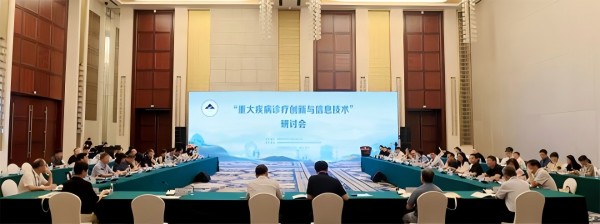
the meeting scene
On August 23, 2024, the “Innovation and Information Technology in Major Disease Diagnosis and Treatment” symposium, co-hosted by the Medical Sciences Department and the Information Sciences Department of the National Natural Science Foundation, and organized by the Innovation Academy for Precision Measurement Science and Technology (APM) of the Chinese Academy of Sciences (CAS), was held in Wuhan. The meeting was chaired by Academician DONG Jiahong from Tsinghua University and Researcher ZHOU Xin from APM. Academician ZHANG Xuemin, a member of the Party Group and Deputy Director of the National Natural Science Foundation, attended the meeting online. SUN Ruijuan, Executive Deputy Director of the Medical Sciences Department of the National Natural Science Foundation, DU Yun, Deputy Director of the Department of Science and Technology of Hubei Province, and Forum Chairman Academician DONG Jiahong delivered speeches at the opening ceremony.
In her opening speech, Executive Deputy Director SUN Ruijuan stated that this symposium on the development strategy of disciplines aims to implement the overall requirements of technological innovation by adhering to the “four orientations”. It is designed to deeply promote the development of the field of smart diagnosis and treatment, leverage the advantage of China's rich clinical resources, discuss the innovative integration of clinical data resources with cutting-edge information technology, and refine the key scientific issues behind major clinical needs. This will provide scientific guidance and strategic recommendations for the future development of the field of major disease diagnosis and treatment.
Deputy Director DU Yun introduced the development situation of Hubei Province in the fields of medical engineering integration, life and health industry, and pointed out that Hubei Province will strongly support the high-quality development of the integration field between medical science and information technology.
In his speech, Academician DONG Jiahong stated that the new round of scientific revolution brought about by information technology has ushered in a transformative new era in modern medicine. Under the guidance of modern medical concepts, the application of digital technology has achieved tremendous improvements. Generative large models have provided important means and tools for digital technology, bringing hope to tackling major disease diagnosis and treatment challenges and solving significant scientific issues. This symposium aims to promote the innovative application of information technology in the field of major diseases. It is hoped that through academic discussions, new strategies and ideas can be provided for the diagnosis and treatment of major diseases and the application of information technology, offering valuable suggestions for China's layout and design in this field.
The symposium focused on topics such as “Integration and Innovation of Clinical Diagnosis and Treatment Information for Major Diseases with Artificial Intelligence”, “Frontier Research and Integration of Drug Development for Major Diseases”, “Frontier Research and Integration of Innovative Medical Devices for Major Diseases”, and “Technological Innovation and Information Integration of Common Scientific Issues in the Diagnosis and Treatment of Major Diseases”, with four invited reports and four keynote speeches arranged. Experts attending the discussion unanimously agreed that the rapid development of information technology has brought revolutionary changes to the diagnosis and treatment of major diseases. Technologies such as artificial intelligence, big data analysis, cloud computing, and the Internet of Things are changing the way diseases are diagnosed and treated. The integration of information technology has become key to enhancing the level of diagnosis and treatment for major diseases in medical research and clinical practice. At the same time, many challenges are faced, such as the complexity of technology integration, data privacy and security issues, data standardization issues, poor explainability of artificial intelligence models, and differences in the effectiveness of technology applications. Further exploring the potential of information technology in the diagnosis and treatment of major diseases, optimizing technology applications, and improving overall diagnostic and treatment levels are important directions for future research.
Academician YE Chaohui and Academician LIU Maili from APM, Academician JIA Weiping from Shanghai Jiao Tong University, Academician WANG Jun from Peking University, Academician ZHANG Xu from the Chinese PLA General Hospital, and 39 experts and scholars from 29 colleges and research institutions across the country, as well as relevant staff from the Medical Sciences Department and Information Sciences Department of the National Natural Science Foundation, attended the meeting.
